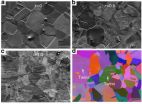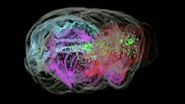(Press-News.org) PROVIDENCE, R.I. [Brown University] — Researchers from Brown University and universities in China have found a simple technique that can strengthen steel without sacrificing ductility. The new technique, described in Nature Communications, could produce steel that performs better in a number of structural applications.
Strength and ductility are both crucial material properties, especially in materials used in structural applications. Strength is a measure of how much force is required to cause a material to bend or deform. Ductility is a measure of how much a material can stretch without breaking. A material that lacks strength will tend to fatigue, failing slowly over time. A material that lacks ductility can shatter, causing a sudden and catastrophic failure.
Steel is one of the rare materials that is both strong and ductile, which is why it's ubiquitous as a structural material. As good as steel is, however, engineers are constantly working to make it better. The problem is that methods of making steel stronger tend to sacrifice ductility and vice versa.
"We call it the strength-ductility tradeoff," said Huajian Gao, professor of engineering at Brown and senior author on this new research. He and his colleagues have found a way around that tradeoff in cylinders made with a particular kind of steel called twinning-induced plasticity (TWIP) steel.
TWIP steel can be made stronger through what's called work hardening. Work hardening is the process of strengthening steel by deforming it — bending it, flattening it, or hammering it on a forge. When TWIP steel is deformed, nanoscale structures called deformation twins form in its atomic lattice. Deformation twins are linear boundaries with identical crystalline structures on either side, forming a mirror image across the boundary. Twin structures are known to make TWIP steel much stronger, but just like other ways of hardening steel, there's a ductility tradeoff.
To evade that tradeoff, Gao and his colleagues introduced a new twist — literally — on the deformation process. Instead of deforming the steel by hammering it or bending it, Gao and his colleagues took small cylinders of TWIP steel and twisted them. The twisting motion causes molecules in the outer parts of the cylinder to deform to a much greater degree than molecules toward the core. The idea is a little like runners on a track. Those running in the outside lanes have more ground to cover than runners on the inside.
Because the twisting motion deforms the outside more than the inside, deformation twins form only toward the surface of the cylinder. The core remains essentially untouched.
The result is a steel cylinder with the best of both worlds — the surface of the cylinder becomes stronger and more resistant to cracking, while the inside retains its original ductility.
"Essentially we partitioned the material into a hardened part near the surface and a softer part near the core," Gao said. "This allowed us to double the strength without sacrificing ductility."
The work in the lab was done with very small cylinders — on the order of centimeters long. However, nothing indicates that the process can't be scaled up to larger cylinders, Gao said.
Eventually, Gao and his colleague hope their technique could be used to pre-treat steel that requires a cylindrical shape—axles or drive shafts on cars for example. In particular, Gao sees torsioned steel as a good option for axles on high-speed trains.
"It's critical to have high strength and high ductility for such an axle component," Gao said. "So it's critical in this kind of system to push this strength-ductility limit as far as possible."
Gao's coauthors on the paper were Yujie Wei (lead author and a former postdoctoral fellow at Brown), Yongqiang Li, Lianchun Zhu, Yao Liu, and Xianqi Lei of the Laboratory of Nonlinear Mechanics, Institute of Mechanics, Chinese Academy of Sciences; Gang Wang of Laboratory for Microstructures, Shanghai University; Yanxin Wu and Zhenli Mi of the University of Science and Technology, Beijing; and Jiabin Liu and Hongtao Wang of Zhejiang University.
INFORMATION:
Editors: Brown University has a fiber link television studio available for domestic and international live and taped interviews, and maintains an ISDN line for radio interviews. For more information, call (401) 863-2476.
A new twist makes for better steel, researchers find
2014-04-08
ELSE PRESS RELEASES FROM THIS DATE:
NASA's Aqua satellite reveals Tropical Cyclone Ita strengthening
2014-04-08
Tropical Cyclone Ita's maximum sustained winds have increased over the last day and NASA's Aqua satellite provided forecasters at the Joint Typhoon Warning Center with a visible look at the storm on April 8.
NASA's Aqua satellite passed over Ita at 3:30 UTC/11:30 p.m. EDT on April 7, and the Moderate Resolution Imaging Spectroradiometer provided a visible image of Tropical Cyclone Ita. The MODIS image showed a large area of strong thunderstorms south and northeast of the center of circulation. At the same time, the Atmospheric Infrared Sounder or AIRS instrument aboard ...
Scientists reveal potential link between brain development and breast cancer gene
2014-04-08
VIDEO:
Scientists at the Salk Institute have uncovered details into a surprising -- and crucial -- link between brain development and BCRA1, a gene whose mutation is tied to breast and ovarian cancer.
Click here for more information.
LA JOLLA—Scientists at the Salk Institute have uncovered details into a surprising—and crucial—link between brain development and a gene whose mutation is tied to breast and ovarian cancer. Aside from better understanding neurological damage associated ...
Why binge drinkers are slower to heal from their wounds
2014-04-08
MAYWOOD, Ill. – People who are injured while binge drinking are much slower to heal from wounds suffered in car accidents, shootings, fires, etc.
Now a new study is providing insights into why alcohol has such a negative effect on wound healing. Loyola University Chicago Stritch School of Medicine researchers report that binge alcohol exposure significantly reduced levels of key components of the immune system involved in healing.
The study by senior author Katherine A. Radek, PhD, and colleagues from Loyola's Alcohol Research Program and the Infectious Disease and ...
Global health funding reaches new high as funding priorities shift
2014-04-08
Washington, D.C.—Global health funding hit an all-time high of $31.3 billion in 2013, five times greater than in 1990. Yet with 3.9% growth from 2012 to 2013, the year-over-year increase falls short of the rapid rates seen over the previous decade, according to new research by the Institute for Health Metrics and Evaluation (IHME) at the University of Washington being published online in a web first edition on April 8 by Health Affairs.
As funding from many bilateral donors and development banks has declined, growth in funding from the GAVI Alliance, the Global Fund ...
UNC researchers find genetic trigger for RSV-induced infant hospitalizations
2014-04-08
April 8, 2014 CHAPEL HILL, N.C. – Researchers at UNC School of Medicine have pinpointed a viral protein that plays a major role in making respiratory syncytial virus (RSV) the most common cause of hospitalization in children under one year of age.
The discovery, published April 8 in the Journal of Clinical Investigation, is the first step toward identifying better diagnostics and potential treatments for an infection that strikes nearly all children before they reach the age of three and causing severe disease in 3 percent of infected children. RSV infection leads to ...
The double whammy of multiple sex partners and drinking in HIV/STI prevention
2014-04-08
PHILADELPHIA (April 8, 2014) – The cartoon character Homer J. Simpson once said "Alcohol: The source of, and solution to, all of life's problems."
The sage of the ubiquitous and fictional town of Springfield may have hit the nail on the head when it comes to human immunodeficiency virus (HIV) and sexually transmitted infections (STIs) counseling and prevention. The more you drink and/or the more sex partners you have, the less likely you are to engage in HIV-prevention programs.
This rather grim assessment came about from the study, "Barriers to accessing HIV-prevention ...
Language structure… you're born with it
2014-04-08
Humans are unique in their ability to acquire language. But how? A new study published in the Proceeding of the National Academy of Sciences shows that we are in fact born with the basic fundamental knowledge of language, thus shedding light on the age-old linguistic "nature vs. nurture" debate.
THE STUDY
While languages differ from each other in many ways, certain aspects appear to be shared across languages. These aspects might stem from linguistic principles that are active in all human brains. A natural question then arises: are infants born with knowledge of how ...
Advanced warning systems increase safety at intersections, study shows
2014-04-08
Most drivers have experienced a traffic signal that turns yellow just as they approach an intersection, which makes it difficult for them to decide whether to stop or proceed through it. The wrong choice in this situation, known as the "dilemma zone," may lead to crashes, especially at high-speed intersections.
A major factor making driving difficult is hazards that are sudden and hard to predict. Roadside and in-vehicle display warning systems may help drivers handle these hazards by predicting their occurrence and providing advanced warning to the driver, according ...
Lipid levels during prenatal brain development impact autism: York U study
2014-04-08
In a groundbreaking York University study, researchers have found that abnormal levels of lipid molecules in the brain can affect the interaction between two key neural pathways in early prenatal brain development, which can trigger autism. And, environmental causes such as exposure to chemicals in some cosmetics and common over-the-counter medication can affect the levels of these lipids, according to the researchers.
"We have found that the abnormal level of a lipid molecule called Prostaglandin E2 in the brain can affect the function of Wnt proteins. It is important ...
Kinesin-5 structure opens cancer drug targets
2014-04-08
VIDEO:
Kinesin-5 plays a crucial role in cell division by allow microfilaments to slide past each other. The kinesin-5 structure shows a central rod connecting two motor units that walk along...
Click here for more information.
The structure of a key part of the machinery that allows cells to divide has been identified by researchers at the University of California, Davis -- opening new possibilities for throwing a wrench in the machine and blocking runaway cell division in cancer.
"The ...





